 |  |
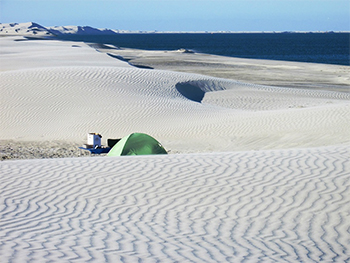
Sand Island (Isla Arena) stretches between the northern side of the entrance to Scammon’s Lagoon (more correctly called Ojo de Liebre) and the southern side of the entrance to Guerrero Negro Lagoon.
The island, well-named, is almost entirely made up of sterile, blinding white dunes. It is approximately 15 miles long and 3 miles wide in places, and runs from northeast to southwest. Sand Island presents the major barrier that separates the Ojo de Liebre/Guerrero Negro lagoon complex from the open Pacific Ocean.
The town of Guerrero Negro was named after a 231-ton American whaling vessel, the Black Warrior, which was wrecked off the northern point of Sand Island in 1858. But perhaps a more significant if less well-known wreck is an1575 Manila galleon that likely came to grief on the island, and from which archeologists have recovered hundreds of pieces of Ming Dynasty porcelain.
Many whale watchers in Scammon’s Lagoon will be familiar with Sand Island… For those utilizing Mario’s Tours or the Malarrimo Hotel’s boats, the snow white dunes are visible almost from the embarkation point near Guerrero Negro’s salt loading facility at El Chaparrito all the way to the whale watching area near the entrance to the lagoon.
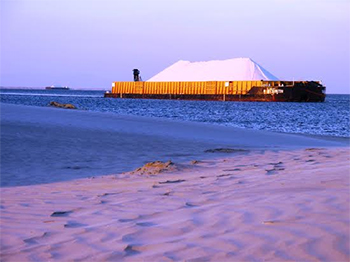
The Guerrero Negro salt harvesting facility, based on solar and wind evaporation of seawater, is the largest in the world, with an annual production around 7 million tons. More than half of the salt is exported to Japan.
The sheltered lagoon next to the island is surprisingly deep. It is utilized as the channel for the large salt barges to depart Ojo de Liebre en route to the deep water harbor on Cedros Island, which can accommodate oceangoing vessels of up to 150,000 tons.
Rain is infrequent in the area, and may not occur for months at a time. The fine powdery sand can’t support a pool or a stream. But somehow a population of unusually bold coyotes call the island home. As I have found to my cost, and sometimes amusement, just about anything left outside a tent at night is likely to disappear.
I first visited Sand Island in 1983 during my round Baja walk. I was several days there in the company of two adventurous American ladies who had arranged a panga ride out to explore its beaches on ATVs. To respect their wishes, I never mentioned that side-trip in my book, Into a Desert Place. Running the length of the island on the back of an ATC brought many treasures and interesting discoveries, and made beachcombing a productive delight.
I have visited the island twice since that time, enjoying camping and hiking along the open Pacific shore, and I was keen to get back for at least one more visit.
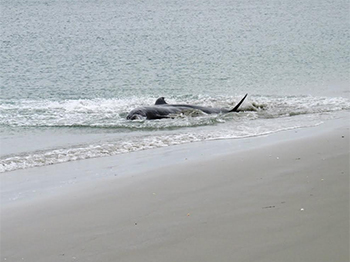
Nearly all of Sand Island now falls within the borders of the Vizcaíno Biosphere Reserve, the largest such protected area in Mexico. The reserve is administered by CONANP, the National Commission of Natural Protected Areas. Special permission is required to visit and is not always granted. Today with strict environmental controls in place, use of ATVs or any kind of motorized vehicles is not allowed. I visited the CONANP headquarters in Guerrero Negro and gave assurances that my intention was simply to walk, camp, document and photograph.
I bought an annual pass, “pasaporte,” there at the CONANP office, which allowed a full year’s access to all parts of the Vizcaíno Biosphere Reserve, and also to all the many parks and protected areas of Mexico for about $29 US. And in an act of gracious generosity, the CONANP park staff offered to arrange panga rides to and from the island for me and look after my vehicle while I was out there
And so, last July, more than 30 years after my first visit, I enjoyed a week of further Sand Island discoveries. I camped a few hundred yards from the mouth of Scammon’s Lagoon, just behind a ridge of low dunes overlooking the lagoon. It offered a great place to watch the salt barges as they were continually towed from the lagoon loaded with salt and towed back empty. And it was a good, relatively sheltered spot to conduct explorations of the surf-lashed shore that faces the open Pacific.
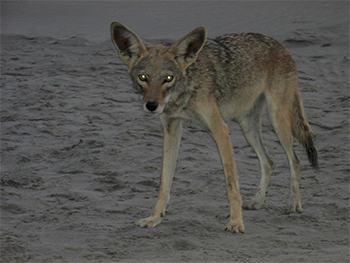
The first night was quiet and relaxing, though I did have to watch the tide which rose exceptionally high. The lights of Guerrero Negro glowed faintly in the distance, and the lights of Puerto El Chaparrito shone even closer and brighter.
However, after the relative calm of the first night, things got a little more adventuresome…
I was standing calf deep in the warm lagoon, about to take a few more steps and immerse myself for a refreshing morning swim in the deep channel, when the water beside me suddenly exploded into the form of a huge dark gray “fish.” And from my perspective and vulnerable position it looked truly huge. It rammed its body half way out of the water and nearly bowled me over. Images of orcas and great white sharks flashed into my mind. Backing smartly away towards the shore, I could see it had chased what looked like a large mullet on to the sand. As I watched, snapping jaws clamped onto the flapping fish and then the creature slid and rolled its bulk back to the water and out of sight.
It was actually a large dolphin. Every day, thrashing, torpedoing dolphins were feeding along the drop-off from the beach and often two or more would be working right in front of my tent.
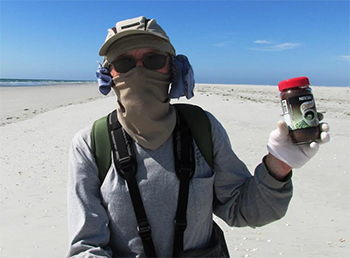
And every night in the glow of my flashlight, zombie-like eyes started to appear widely circling in the blackness. Short of space in my tent, I had foolishly left a gallon of water and a two-liter bottle of diet coke on a chair right outside my tent door. Both silently disappeared in the night. The chewed up empty plastic water jug was found 100 yards away surrounded by abundant coyote tracks. The still full coke bottle only made it half as far and was still intact, apart from a few bite marks around the cap.
Next night, my chair disappeared! Dawn revealed that it had been dragged 50 feet away. Another night a plastic bowl of seawater used for washing ended up being pulled from my table and loudly crashing and spilling onto the sand.
And so for the rest of the week I ended up losing sleep, chasing troublesome coyotes along the shore… usually after being jolted awake around 2 or 3 AM. Displaying cooperative smarts, some coyotes would double back and re-visit my camp while I was down the beach hurling wooden “clubs” and words of discouragement at their colleagues
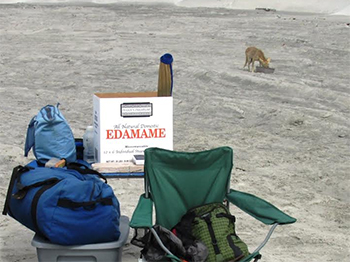
The fascinating open Pacific shore of the island is crammed with stuff—mostly discarded plastic and glass, and vast amounts of driftwood. But there are also occasional items of interest—welcome additions like an unopened jar of Nescafé coffee, and others less so, like a ripped-open 30-40 pound bale of marijuana and several obviously dumped, full containers of gasoline!
While I’m glad I didn’t make the acquaintance of the thwarted marijuana runners, I actually grew rather fond of my coyote visitors and certainly sympathized with their desperate need for water. As I was away from my camp for hours every day, I was also grateful to return and find that my tent and its vulnerable contents had remained unmolested.
One of the coyotes in particular seemed to grow increasingly bold… and began to linger in the morning long after its companions had disappeared. On my last morning, I left it a gallon of water in a driftwood plastic bowl, a few tortillas and the contents of a packet of sardines. And as I was leaving the island, the panguero park custodian pointed back to the shore and said, “Is that your dog?” The coyote was bounding along, following as if it didn’t want to be left behind!
It had been a wonderful week, a privilege to have had once more an uninhabited desert island all to myself. Camera in hand, I had spent many fascinating hours turning over planks and boards to see what other creatures called the island home. Scorpions, mice, lizards and assorted spiders and insects were all spotted. But the undisputed lords of Sand Island, at least in July, were the coyotes on the land and the dolphins in the surrounding waters.
The only whales were several dead ones encountered on the Pacific beaches… and they had clearly provided abundant sustenance for coyotes and vultures. It would be another 5-6 months before the gray whales would return and bring boatloads of whale watchers to experience their friendly encounters right there at the entrance to Scammon’s Lagoon, right off the shore of Sand Island.

Great coverage options . Price buy and print policy , very quick and easy , highly recommend them...

Baja Bound could not have made it an easier ... also, I made a mistake and called them having to...

Easy process and very informative and supportive.